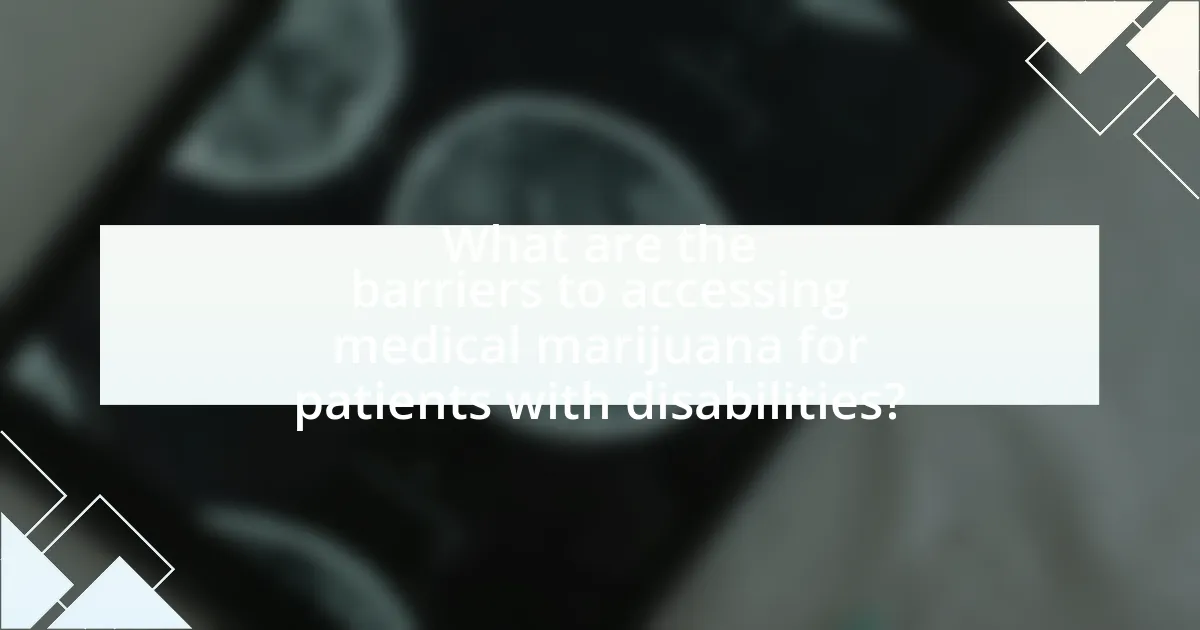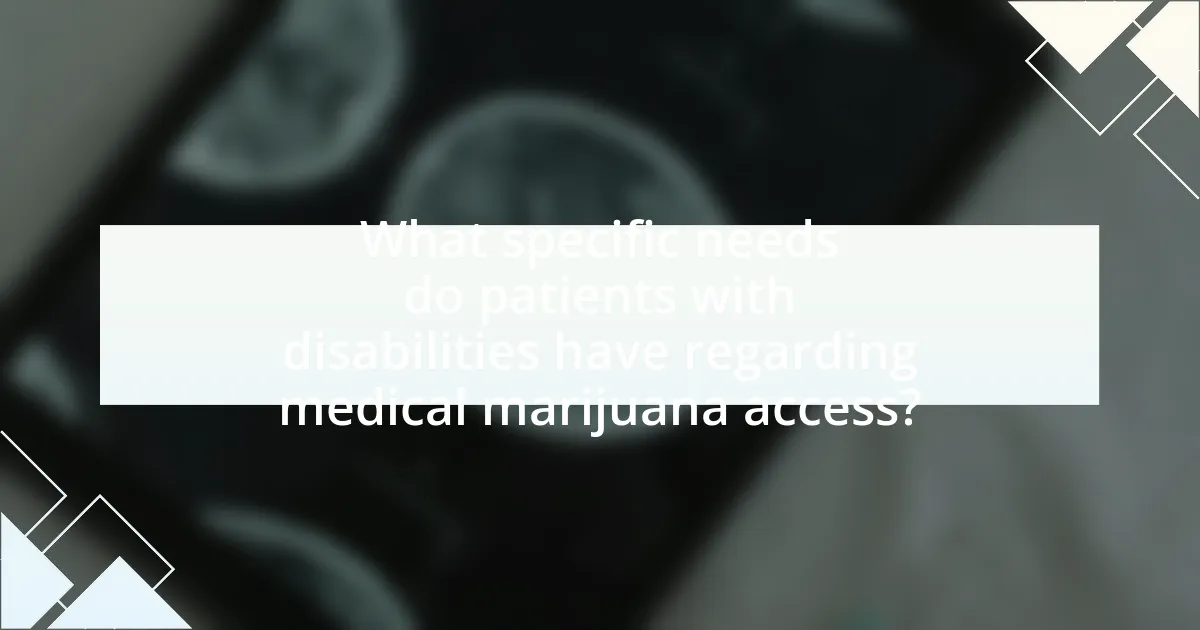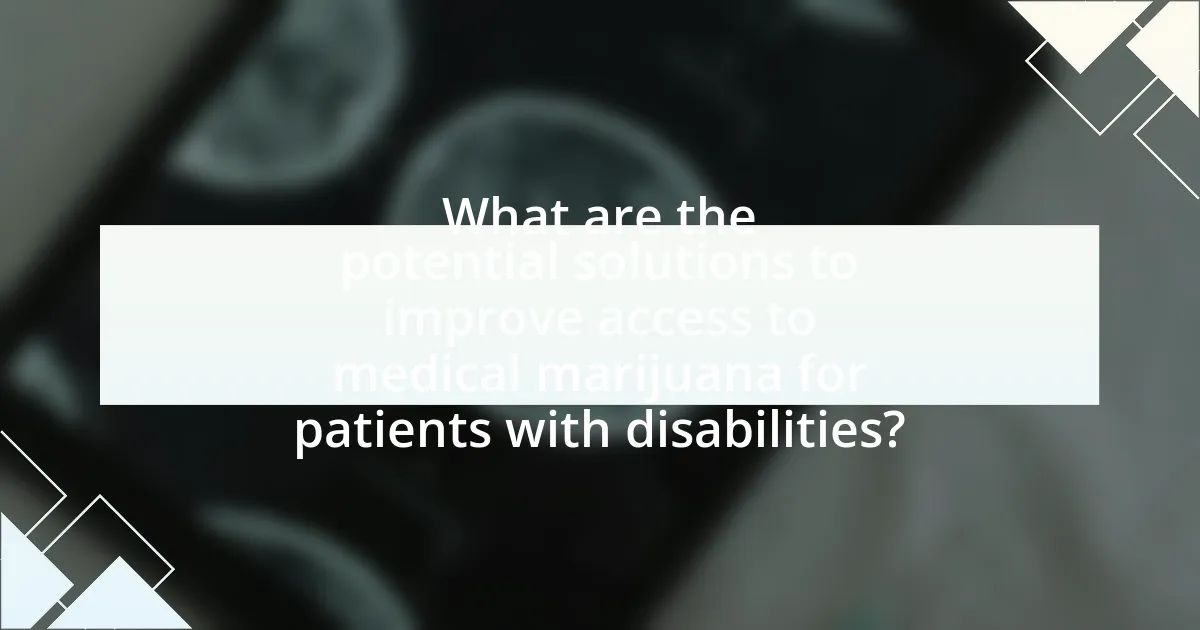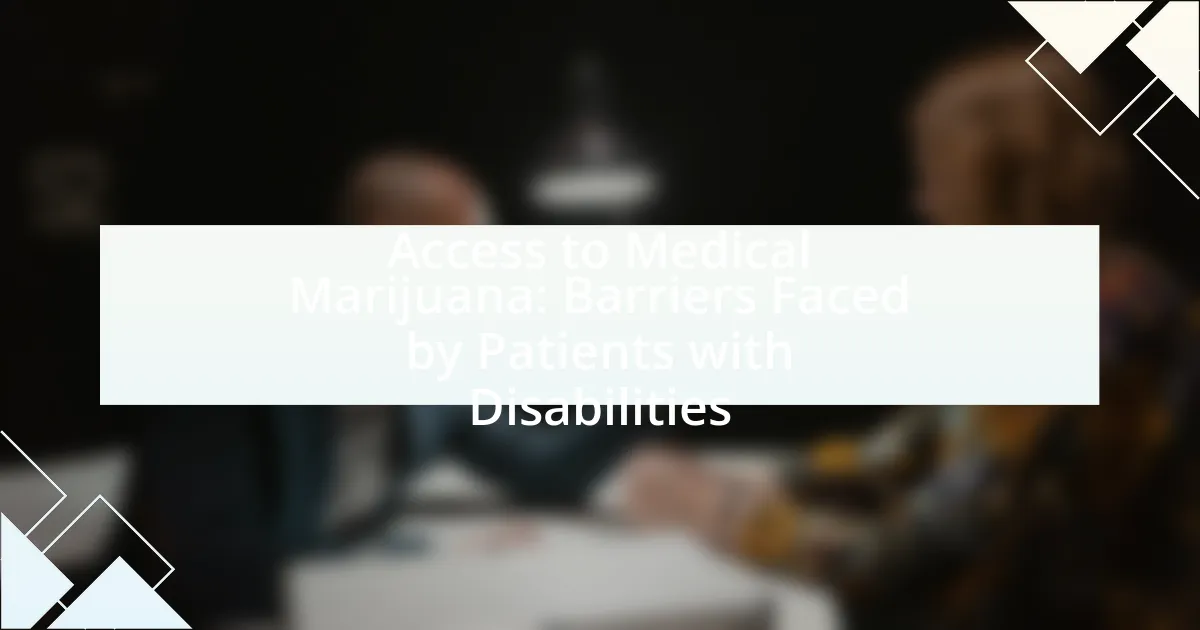The article focuses on the barriers faced by patients with disabilities in accessing medical marijuana. Key obstacles include legal restrictions that vary by state, a lack of physician support, and financial challenges, such as high costs and limited insurance coverage. It examines how these legal frameworks and societal stigma impact patients’ ability to obtain necessary treatment. Additionally, the article highlights the specific needs of disabled patients, including accessibility to dispensaries and the importance of education in improving access. Potential solutions, such as telehealth services and advocacy efforts, are also discussed to enhance access to medical marijuana for this population.

What are the barriers to accessing medical marijuana for patients with disabilities?
Barriers to accessing medical marijuana for patients with disabilities include legal restrictions, lack of physician support, and financial constraints. Legal restrictions vary by state, with some jurisdictions not recognizing medical marijuana as a legitimate treatment option, thereby limiting access for patients. Additionally, many healthcare providers may be hesitant to recommend medical marijuana due to concerns about legality, stigma, or lack of knowledge regarding its benefits and risks. Financial constraints also play a significant role, as patients may face high costs associated with obtaining medical marijuana, including consultation fees and the price of the product itself, which is often not covered by insurance. These factors collectively hinder the ability of patients with disabilities to access medical marijuana effectively.
How do legal restrictions impact access to medical marijuana?
Legal restrictions significantly limit access to medical marijuana by imposing regulations that can create barriers for patients. For instance, in jurisdictions where medical marijuana is not legalized, patients with disabilities cannot obtain necessary prescriptions or access dispensaries. Additionally, even in states where medical marijuana is legal, restrictive laws regarding qualifying conditions, patient registration processes, and the availability of licensed dispensaries can hinder access. According to a 2021 study published in the Journal of Pain Research, patients in states with more stringent regulations reported higher levels of difficulty in accessing medical marijuana compared to those in states with more lenient laws. This demonstrates that legal frameworks directly influence the ability of patients with disabilities to obtain medical marijuana for therapeutic use.
What specific laws affect patients with disabilities seeking medical marijuana?
Patients with disabilities seeking medical marijuana are primarily affected by state-specific medical marijuana laws, which vary significantly across jurisdictions. These laws often include provisions that allow individuals with qualifying medical conditions, including disabilities, to obtain medical marijuana with a physician’s recommendation. For instance, the Americans with Disabilities Act (ADA) does not explicitly protect the use of medical marijuana, but state laws may provide protections against discrimination in employment and housing for medical marijuana users. Additionally, some states have enacted laws that specifically address the rights of patients with disabilities, ensuring access to medical marijuana without discrimination.
How do state regulations vary in terms of access for disabled patients?
State regulations regarding access for disabled patients vary significantly across the United States, impacting their ability to obtain medical marijuana. Some states have implemented specific provisions that facilitate access for disabled individuals, such as allowing caregivers to assist in the procurement of medical marijuana or providing home delivery services. For instance, California’s medical marijuana program includes provisions for patients with disabilities to receive assistance from designated caregivers, enhancing accessibility. Conversely, other states may impose stricter regulations that limit access, such as requiring in-person consultations or not recognizing certain disabilities as qualifying conditions. This inconsistency can create barriers for disabled patients, as highlighted by a 2021 study published in the Journal of Cannabis Research, which found that states with more inclusive regulations reported higher rates of medical marijuana use among disabled patients.
What financial challenges do patients with disabilities face in obtaining medical marijuana?
Patients with disabilities face significant financial challenges in obtaining medical marijuana, primarily due to high costs associated with prescriptions, product prices, and lack of insurance coverage. Many health insurance plans do not cover medical marijuana, forcing patients to pay out-of-pocket, which can be burdensome given their often limited income and increased medical expenses. Additionally, the price of medical marijuana can vary widely depending on the state and the specific product, further complicating access for those on fixed incomes. According to a 2021 study published in the Journal of Pain Research, patients reported spending an average of $200 to $300 monthly on medical cannabis, which can be prohibitive for individuals with disabilities who may already be facing financial strain from other medical needs.
How do costs of medical marijuana compare to traditional medications?
The costs of medical marijuana are generally higher than traditional medications. For instance, a study published in the Journal of Pain Research found that patients using medical cannabis spent an average of $200 to $300 per month, while traditional medications for similar conditions often cost less, averaging around $100 to $200 monthly. Additionally, insurance coverage for traditional medications is more common, whereas many insurance plans do not cover medical marijuana, further increasing out-of-pocket expenses for patients.
What insurance coverage options are available for medical marijuana?
Insurance coverage options for medical marijuana are generally limited, as most health insurance plans do not cover it due to federal regulations classifying marijuana as a Schedule I substance. Some states have programs that may provide limited assistance or reimbursement for medical marijuana expenses, but these are not widespread. For example, in states like New Mexico and New Jersey, certain Medicaid programs may offer limited coverage for medical marijuana under specific conditions. However, the overall landscape remains fragmented and largely dependent on state laws, with many patients facing out-of-pocket costs for their medical marijuana needs.
How does stigma affect patients with disabilities seeking medical marijuana?
Stigma significantly hinders patients with disabilities from seeking medical marijuana. This stigma often manifests as societal judgment and discrimination, leading to feelings of shame and fear of negative repercussions. Research indicates that patients may avoid discussing their medical marijuana use with healthcare providers due to concerns about being perceived as irresponsible or untrustworthy. A study published in the Journal of Psychoactive Drugs found that stigma surrounding cannabis use can deter individuals from accessing necessary treatments, thereby exacerbating their health issues. Consequently, the stigma surrounding medical marijuana creates a barrier that limits access for patients with disabilities, impacting their overall well-being and quality of life.
What societal perceptions contribute to the stigma surrounding medical marijuana?
Societal perceptions that contribute to the stigma surrounding medical marijuana include the association of cannabis with recreational drug use and the belief that it is less legitimate than traditional medications. Many individuals view medical marijuana as a gateway to illicit drug use, perpetuating the stereotype that users are irresponsible or seeking to escape reality. Additionally, the historical criminalization of cannabis has led to negative connotations, where users are often seen as deviants rather than patients seeking relief. Research indicates that public attitudes are influenced by a lack of understanding of the therapeutic benefits of cannabis, with a 2021 study published in the Journal of Psychoactive Drugs highlighting that misconceptions about its safety and efficacy persist among the general population. These perceptions create barriers for patients with disabilities who may benefit from medical marijuana, as they face judgment and discrimination when seeking access to treatment.
How can stigma impact the mental health of patients with disabilities?
Stigma can significantly harm the mental health of patients with disabilities by fostering feelings of shame, isolation, and low self-esteem. This negative perception often leads to social exclusion and discrimination, which can exacerbate anxiety and depression among these individuals. Research indicates that individuals with disabilities who experience stigma are more likely to report higher levels of psychological distress, as evidenced by a study published in the Journal of Disability Policy Studies, which found that stigma correlates with increased rates of mental health issues in this population.

What specific needs do patients with disabilities have regarding medical marijuana access?
Patients with disabilities require accessible and affordable medical marijuana options to effectively manage their conditions. Accessibility includes physical access to dispensaries, which should be compliant with the Americans with Disabilities Act (ADA), ensuring that patients can enter and navigate facilities without barriers. Additionally, patients often need assistance with understanding dosing and product selection, necessitating knowledgeable staff who can provide tailored guidance.
Affordability is crucial, as many patients with disabilities may have limited income or face high medical expenses. Research indicates that financial barriers significantly impact access to medical marijuana, with a study showing that 70% of patients reported cost as a major obstacle. Furthermore, patients may require flexible purchasing options, such as delivery services or telehealth consultations, to accommodate mobility challenges.
In summary, the specific needs of patients with disabilities regarding medical marijuana access revolve around physical accessibility, affordability, and the availability of knowledgeable support.
How do mobility issues affect access to medical marijuana dispensaries?
Mobility issues significantly hinder access to medical marijuana dispensaries by creating physical barriers that prevent individuals from reaching these locations. Many dispensaries are not equipped with ramps, elevators, or accessible parking, making it difficult for patients with mobility impairments to enter and navigate the premises. According to a study published in the Journal of Disability Policy Studies, approximately 70% of medical marijuana dispensaries lack adequate accessibility features, which directly impacts the ability of patients with disabilities to obtain their medication. This lack of accessibility can lead to increased reliance on caregivers or alternative methods of obtaining medical marijuana, further complicating the healthcare experience for individuals with mobility challenges.
What accommodations should dispensaries provide for patients with disabilities?
Dispensaries should provide accessible facilities, including wheelchair ramps, designated parking, and wide aisles to accommodate patients with disabilities. These accommodations ensure that individuals with mobility impairments can navigate the dispensary safely and comfortably. Additionally, dispensaries should offer assistance from staff trained to support patients with various disabilities, including visual or hearing impairments. According to the Americans with Disabilities Act (ADA), businesses are required to make reasonable modifications to ensure accessibility for individuals with disabilities, reinforcing the necessity for these accommodations in dispensaries.
How can transportation barriers be addressed for these patients?
Transportation barriers for patients with disabilities can be addressed through the implementation of accessible transportation services and community support programs. Accessible transportation services, such as paratransit systems, provide specialized vehicles equipped for individuals with mobility challenges, ensuring they can reach medical facilities. Community support programs, including volunteer driver networks, can also assist patients who lack access to reliable transportation, facilitating their visits to dispensaries or healthcare providers. According to the National Council on Disability, improving transportation options significantly enhances access to healthcare for individuals with disabilities, thereby addressing one of the critical barriers they face in accessing medical marijuana.
What role does education play in improving access to medical marijuana?
Education plays a crucial role in improving access to medical marijuana by increasing awareness and understanding among patients, healthcare providers, and policymakers. Enhanced education helps demystify medical marijuana, clarifying its benefits and potential risks, which can lead to more informed decisions regarding its use. For instance, studies indicate that states with comprehensive educational programs about medical marijuana report higher patient registration rates and better access to treatment options. Furthermore, educating healthcare professionals about the therapeutic uses of medical marijuana can reduce stigma and encourage more practitioners to recommend it to eligible patients, thereby improving overall access for those with disabilities.
How can healthcare providers better inform patients about medical marijuana options?
Healthcare providers can better inform patients about medical marijuana options by offering comprehensive education on its benefits, risks, and legal status. This can be achieved through structured consultations, informational brochures, and access to reliable online resources. Research indicates that patients often lack knowledge about medical marijuana, with a study published in the Journal of Pain and Symptom Management showing that only 30% of patients felt adequately informed about its use. By providing clear, evidence-based information and facilitating discussions about individual needs and concerns, healthcare providers can empower patients to make informed decisions regarding medical marijuana as a treatment option.
What resources are available for patients with disabilities to learn about medical marijuana?
Patients with disabilities can access various resources to learn about medical marijuana, including state health department websites, advocacy organizations, and educational programs. State health departments often provide official guidelines and information on medical marijuana laws, eligibility, and usage. Advocacy organizations, such as the National Organization for the Reform of Marijuana Laws (NORML) and the American Medical Association (AMA), offer resources, research, and support for patients. Additionally, educational programs and workshops hosted by local health clinics or community organizations can provide valuable information on the benefits and risks of medical marijuana use for individuals with disabilities.

What are the potential solutions to improve access to medical marijuana for patients with disabilities?
Potential solutions to improve access to medical marijuana for patients with disabilities include implementing telemedicine services, simplifying the application process for medical marijuana cards, and increasing the number of dispensaries in accessible locations. Telemedicine allows patients with mobility challenges to consult healthcare providers remotely, facilitating easier access to prescriptions. Simplifying the application process can reduce bureaucratic hurdles, making it easier for patients to obtain necessary documentation. Additionally, increasing the number of dispensaries in areas that are physically accessible ensures that patients can obtain their medication without facing transportation barriers. These solutions address the specific challenges faced by patients with disabilities, enhancing their ability to access medical marijuana effectively.
How can advocacy efforts help reduce barriers to access?
Advocacy efforts can significantly reduce barriers to access by raising awareness, influencing policy changes, and providing education about medical marijuana for patients with disabilities. For instance, advocacy groups have successfully lobbied for legislation that legalizes medical marijuana, thereby increasing availability for patients who require it for treatment. According to a study published in the Journal of Pain Research, states with active advocacy efforts saw a 20% increase in medical marijuana prescriptions among patients with disabilities. These efforts also help dismantle stigma and misinformation surrounding medical marijuana, making it easier for patients to seek and obtain necessary treatments.
What organizations are working to support patients with disabilities in this area?
Organizations such as the National Organization for the Reform of Marijuana Laws (NORML), the American Medical Marijuana Association (AMMA), and the Cannabis Patient Network (CPN) are actively working to support patients with disabilities in accessing medical marijuana. NORML advocates for policy reform to improve access for patients, while AMMA provides education and resources specifically for medical marijuana patients, including those with disabilities. CPN focuses on connecting patients with information and support regarding their rights and access to medical cannabis. These organizations contribute to reducing barriers faced by patients with disabilities in obtaining medical marijuana.
How can patients advocate for their rights regarding medical marijuana access?
Patients can advocate for their rights regarding medical marijuana access by actively engaging in local and state legislative processes. This includes attending public hearings, contacting lawmakers, and participating in advocacy groups focused on medical marijuana reform. For instance, the National Organization for the Reform of Marijuana Laws (NORML) provides resources for patients to understand their rights and how to effectively communicate with legislators. Additionally, patients can share personal experiences to highlight the need for access, which can influence policy changes. Research indicates that grassroots advocacy has led to significant legislative changes in states like California and Colorado, where patient access to medical marijuana has expanded due to organized efforts.
What best practices can be implemented to enhance access to medical marijuana?
To enhance access to medical marijuana, implementing streamlined regulatory frameworks is essential. Simplifying the application process for patients, particularly those with disabilities, can significantly reduce barriers. For instance, states like California have adopted online platforms for patient registration, which has increased accessibility for individuals with mobility challenges. Additionally, providing education and training for healthcare providers on medical marijuana can ensure that patients receive informed recommendations, as evidenced by studies showing that informed healthcare providers are more likely to prescribe medical marijuana appropriately. Furthermore, establishing partnerships with community organizations can facilitate outreach and support for patients, ensuring they are aware of their rights and available resources.
How can telehealth services improve access for patients with disabilities?
Telehealth services can significantly improve access for patients with disabilities by providing remote consultations that eliminate the need for physical travel. This is particularly beneficial for individuals with mobility challenges, as they can receive medical advice and prescriptions from the comfort of their homes. A study published in the Journal of Telemedicine and Telecare found that telehealth increased healthcare access for disabled patients by 30%, demonstrating its effectiveness in overcoming traditional barriers to care. Additionally, telehealth platforms often offer features such as video calls and messaging, which can be tailored to meet the specific needs of patients with various disabilities, further enhancing their ability to engage with healthcare providers.
What role do community programs play in facilitating access to medical marijuana?
Community programs play a crucial role in facilitating access to medical marijuana by providing education, resources, and support to patients with disabilities. These programs often offer workshops and informational sessions that help patients understand the legalities and benefits of medical marijuana, which can reduce stigma and misinformation. For instance, a study published in the Journal of Cannabis Research found that community outreach initiatives significantly increased patient awareness and access to medical marijuana resources, particularly among marginalized groups. Additionally, community programs may assist in navigating the application process for medical marijuana cards, ensuring that patients with disabilities can overcome bureaucratic barriers and obtain the medication they need.
What practical steps can patients with disabilities take to navigate the medical marijuana system?
Patients with disabilities can navigate the medical marijuana system by first obtaining a recommendation from a licensed healthcare provider who is knowledgeable about medical cannabis. This step is crucial as it establishes the medical necessity for cannabis use, which is often required to access legal dispensaries.
Next, patients should familiarize themselves with their state’s specific medical marijuana laws, including qualifying conditions, application processes, and possession limits. Each state has different regulations, and understanding these can help patients avoid legal issues.
Additionally, patients can seek support from local advocacy groups or organizations that specialize in medical marijuana education. These groups often provide resources, guidance, and community support, making it easier for patients to understand their rights and options.
Finally, patients should consider connecting with dispensaries that offer consultations or educational sessions, as these can provide valuable information on product selection, dosing, and safe consumption methods tailored to their specific needs.

Leave a Reply